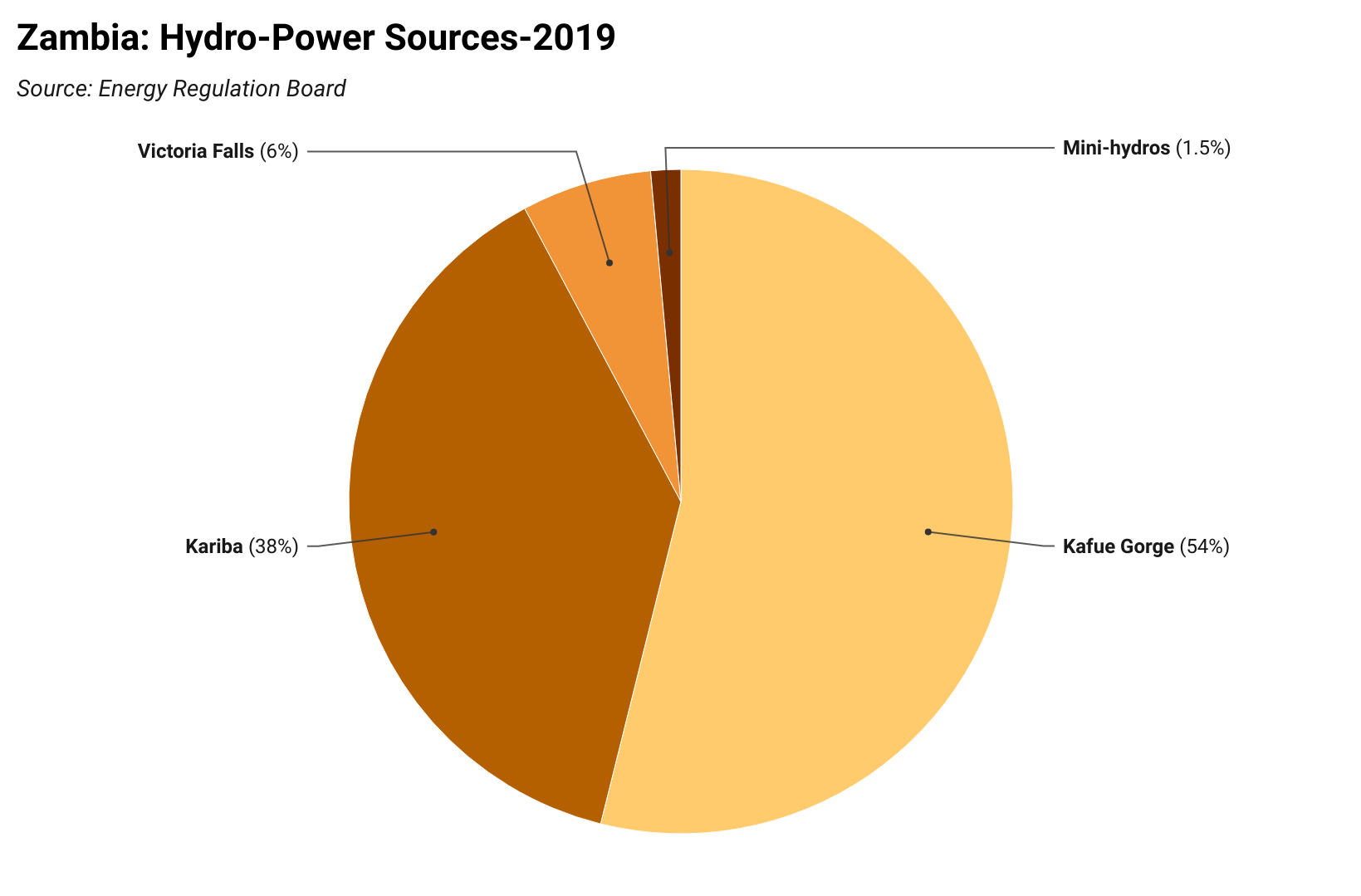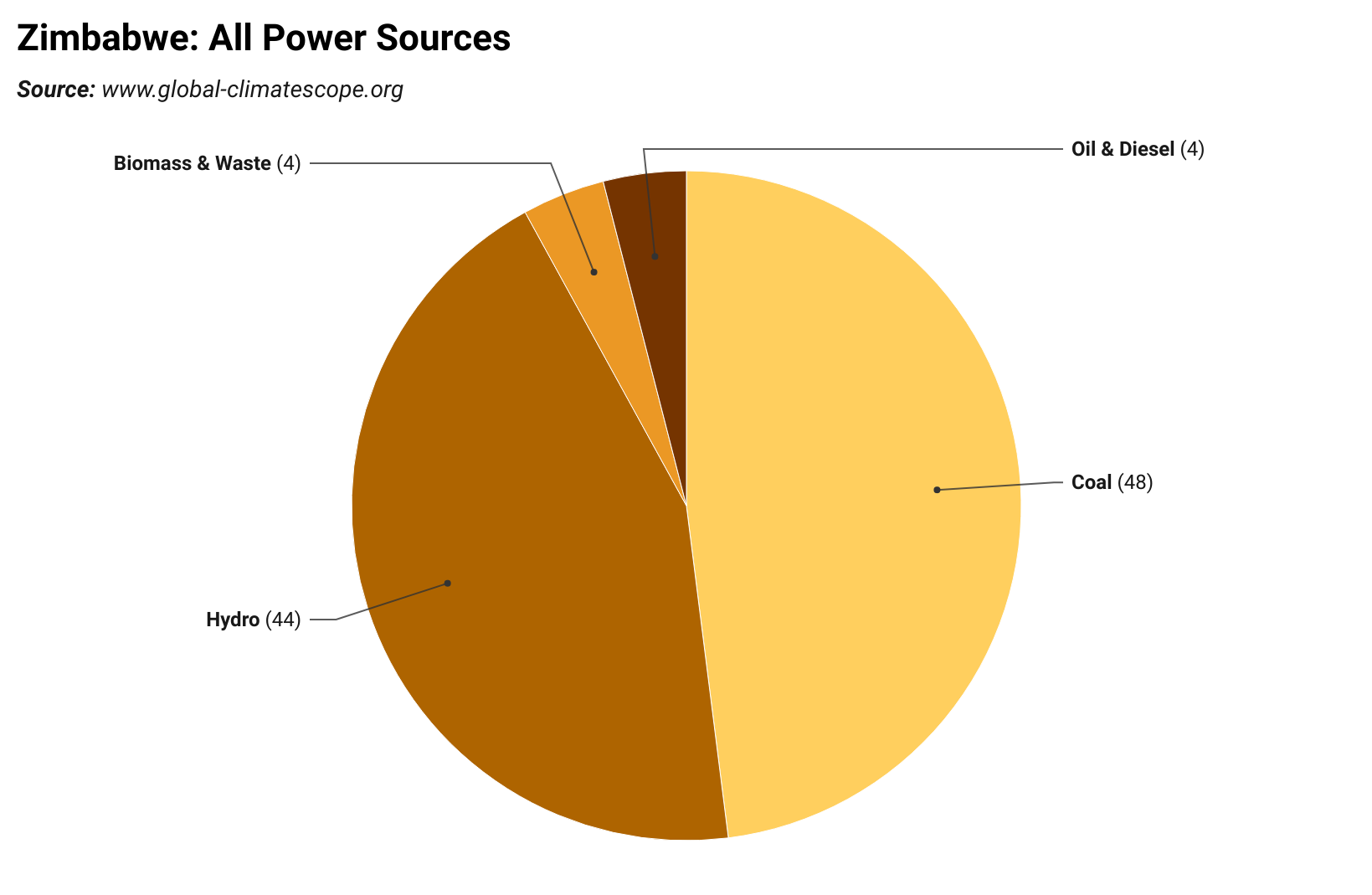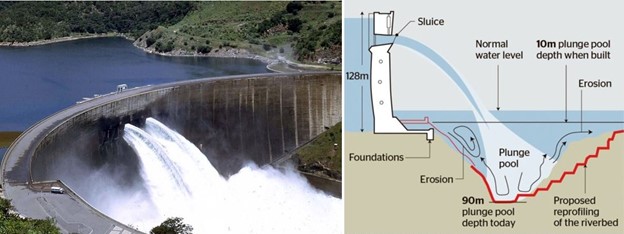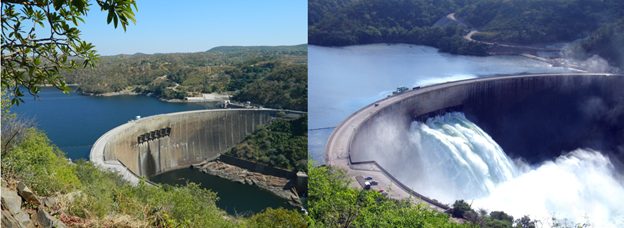The river and the old dam
- 11 minutes read - 2157 wordsHolding back a mighty river
At 62 years old, Lake Kariba, created by the construction of a dam across the Zambezi is a scenic lake in the middle of southern Africa feed by many rivers. The lake is the largest human-created reservoir in the world—a symbol of humans shaping and bending nature towards their own comforts. The Zambezi is the largest of the rivers that feed the lake. Its waters on their way to the Indian ocean, 800 miles (1,290km) downstream of the dam, are held back, if only for a time, by the dam—a 420ft (128m) high arched concrete wall. The Zambezi itself rises at an elevation of about 4,900ft (1,494m) at Kaleni Hill in Northwestern province in Zambia. By the time its waters have tumbled over the Mosi-o-tunya at peak flow, the river is a deluge of such energy and volume, it is enough to drown the army and chariots of a pharoah, and enough to power two nations. And that, of course, is why the jointly owned dam was built: to provide hydroelectric power to Zambia and Zimbabwe.
The dam is now aging, and age is unforgiving even to concrete. But age aside, in even greater measure, the river exacts its own toll. The dam holding back the river in an apparent stalemate all these years is no passive act. Unseen is a relentless force; a ceaseless buildup and concentration of the river’s might in the lake ranged against the wall. It is a concentration of water from as far afield as Luena in Angola to the northwest, Solwezi due north near the border of Zambia and the Democratic Republic of Congo, Choma in the Southern province of Zambia; and in Zimbabwe the waters may have travelled from as far south as Gweru and also from the western vicinity of Harare. Along the length of the Zambezi itself, the waters have travelled from Mongu, Senanga, Sesheke and Livingstone and of course there are towns on its tributaries, Kabombo, Mwinilunga etc.
These are the gathered forces from all these places, near and far-off and in between, that the dam must face. This fluid force and power, manifest and awesome at Mosi-o-tunya 250 miles (402km) upstream, frothing and fearsome through the wild whitewater rapids in the gorges below the falls where the Zambezi cuts through perpendicular walls of basalt 65ft to 200ft (20m to 60m) apart and 650ft to 820ft (198m to 250m) high,1 lays diffuse yet just as potent beneath the placid surface of the lake at the dam.
When too much river water reports to the lake, and the lake threatens to over-top the dam, more so during an ample rain season, six spillways built into the concrete on the upper section of the dam, underneath the roadway running on the roof of the dam, must be opened.The river spews out from the lake in torrents; angry, uncoiling and hurling itself on down the other side of the dam to land in the plunge pool below with much fury as if after revenge for the insult of the interrupted journey to the ocean. There beneath the froth, a fierce war carries on between the river and the footings of the dam-wall. The turbulent abandon the river throws itself down with from the spillways scours the bedrock at the bottom of the course creating a pit at the foot of the dam. The pit was only 33ft (10m) deep at the commissioning of the dam in 1959, it is now 295ft (90m) deep. The increasing depth of the pit in the plunge pool undermines the wall-footings.
The water in the lake does something else besides hustle the wall and erode its footings while its minders are not looking. The full storage volume of the lake is 6,500 billion ft3 (184km3)—this volume of water translates to 198 billion tons (180 billion metric tonnes) in mass. Its location in a tectonically active area at the southern tip of the African Rift Valley causes earthquakes, 20 of them reported to be more than magnitude 5 on the Richter scale.2 This is part of the Zambezi river’s patient strategy to eventually topple the troublesome double curvature mass of concrete; one scoured insignificant bit of river-course-bottom carried to the ocean at a time so the river can carry on flowing uninterrupted as it had for eons before the dam was built.
These are the essentials of this epic struggle: between river and dam, water and humans, nature and technology. The river seeks to regain uninterrupted its leisurely, and other times, ferocious flow on the valley bottom; humans envious of river’s power, strive to continue usurping that power for themselves. The river will surely win. The lifespan of the dam is imperceptible compared to the river’s lifespan of hundreds of millions of years.
Civil designers casting a speculative wary gaze into the future when fortifying structures against nature, against acts of God, have thought in terms of 10,000-year events. Beyond that, they waver. That is, they can make allowance to mitigate the damaging effects of a natural catastrophic event such a rainstorm or earthquake of such rare ferocity that it may occur only once in 10,000 years. Another way to put it is a 10,000-year event has 0.01% of happening in any given year. Anything much more malevolent and even rarer, they leave up to God. Along these lines, the Kariba Dam was designed to store and safely discharge a 1-in-10,000-year event inflow of 3,250 billion ft3 (92.3 km3) over a 3-month period.2
With time on its side, it is either the rivers’ own imperceptible patient work or that event of such rare ferocity that considerations and plans for its occurrence are beyond a reasonable budget, and outside the reach and rules of the probability calculations of engineers that we can expect will one day take down the dam.
The river as a source of power
While it stands though, the Kariba dam feeds Zambia and Zimbabwe hydroelectric power by supplying water to two underground hydropower stations, tens of thousands of tonnes of fish and provides recreation on more than 2,124miles2 (5,500km2 ) of open water. Electricity, however, is why it must continue to stand.
In the case of Zambia, its population was 3.5 million at independence in 1964—6 years after the dam was built. The population in 2021 is close to 18 million. The power needs of Zambia are vastly different compared to 1964. Zimbabwe is in a similar place. As of 2020, both Zambia and Zimbabwe ran large deficits between the electric power requirements for each country and the power they delivered for industrial and residential consumption. They resorted to 12 to 18 hours of load-shedding for all their citizens to have electricity some of the time. The Kariba dam alone cannot and was never meant to answer in full and meet the power deficits of rapidly populating nations, but it is an integral part of the complete solution.
Between 1977 and 1996 the average power output of the Kariba was about 6400GWh per annum,2 and by 1998, the dam had generated 202, 000 GWh of power for the two countries. This is equivalent to burning 100 million tons of coal.2 And building coal fired power plants at several locations in Zimbabwe and at copper mines in Zambia2 would have been the alternative to building the dam. The cost of power came down too. Calculated for the years between 1961 and 1977, the cost of power reduced by 30%, whereas the average price of other commodities and services rose by more than 75%; a 105% swing in power price for the better.2 The Kariba’s munificent largess to economies of Zambia and Zimbabwe and for the planet as whole is obvious.
In 2019, hydroelectricity was 80% of all installed power capacity in Zambia, and from the north bank the Kariba dam has 38% of total installed hydroelectricity.


On its South bank the Kariba dam hosts Zimbabwe’s biggest hydro-power plant with 1,050MW installed capacity, 44% percent of Zimbabwe’s total installed power capacity.

Mending the dam
To keep this power flowing and available now, and for the next generation or two, Zambia and Zimbabwe are executing a complex phased plan to mend the dam where the Zambezi has ravaged it: the plunge pool is getting deeper, eroding back toward the dam, faults have appeared on the upstream face of the dam and the spillways risk getting stuck in an open or closed position because the concrete openings they once snuggly fit in have ever so slightly changed size and shape.

Plunge pool schematic: source: Institute of Risk Management South Africa
The repair plans represent an extraordinary feat of engineering. The first task is to fix the plunge pool bottom. It will be reshaped to create smoother laminar flow directed away from the dam toward downstream. Repairing the plunge pool requires a dry work area for equipment mobility and rock blasting on the downstream side of the dam. Emptying and drying a section of riverbed of a living mighty river, although routine in civil engineering, is really a near miracle. In this case, drying the riverbed will start with the creation of a temporary dam, a cofferdam. The temporary dam will prevent backflow of the Zambezi from upstream into the void created by the drained plunge pool at the foot of the main dam. Underwater divers will erect the cofferdam on the downstream edge of the plunge pool and pump out water entrapped between the resident Kariba dam and the cofferdam. In appearance, the completed work area will resemble a small open pit mine with a ramp going around the sides of the pit from the rim to the bottom for empty trucks to descend to the bottom, and for trucks loaded with excavated earth and blasted rock to ascend to the top. The plunge pool will be reshaped, and its upstream face resurfaced and strengthened with reinforced concrete; a fault near the foot of the dam will be mended too. When the work is complete, after 10.5 million ft3 (297,000 m3) of rock will have been excavated and removed, the plunge pool will be slowly filled with water by removing the pieces of the cofferdam.
To be tackled in the second phase of the repair works are the six spillways, which are 28.9ft (8.8m)-wide and 29.5ft (9m)-high3 near-square apertures with huge gates that seal-off water back in the lake—holding back the river as needed. Effectively, these six aperture-gate devices are massive control valves that can each swallow three 18-wheelers driving side-by-side with room to spare. Over time, the engineered flush snug fit of aperture and gate has deteriorated affecting the smooth opening and closing of the spillway gates. This creates potential for the gates to jam in an open or closed position; both states mean loss of human control over the quantity of water going down stream exposing communities and the environment down-river to flood risk.

source: https://constructionreviewonline.com/
Fixing the spillways is just as complex an engineering challenge as the repair of the plunge pool in phase one of the project. It too requires the creation of a dry work area, in this case, on the upstream face of the wall. In a manner analogous to the repair and re-enforcing of the plunge pool, underwater divers will install a cofferdam for each spillway, and they will drain the water in the cofferdam to create the dry workspace before installing a new gate prefabricated offsite and transported to the site by ship and land. That will be the end of the repair works. The dam will, for a time being, be armored against the river’s malevolent intentions.
The works are sponsored and managed by the Zambezi River Authority on behalf of Zambia and Zimbabwe and estimated to cost US$290 million. They are funded by: 4
- Zambezi River Authority - US$19.2m,
- The African Development Bank - US$75m,
- The World Bank - US$75, Sweden - US$20,
- The European Union - US$100m.
When the works are finished, the Kariba dam will have at least 100 years added to its lifespan. The dam will be counted on to continue supplying power to Zambia and Zimbabwe well into the future. The great river’s efforts at toppling the dam, will be, for the time being, checked and futile, until, in conspiracy with time, the river will once again start scouring and carrying off one insignificant bit of plunge-pool-bottom at a time to the Indian ocean. Humans may once again shore up their wonderous creation, but that is a story for another generation to write.
-
New world encyclopedia - https://www.newworldencyclopedia.org/entry/Zambezi_River ↩︎
-
Soils Incorporated (Pty) Ltd and Chalo Environmental and Sustainable Development Consultants.2000. Kariba Dam Case Study, prepared as an input to the World Commission on Dams, Cape Town. ↩︎
-
https://www.nsenergybusiness.com/projects/kariba-south-power-station/ ↩︎
-
https://www.worldbank.org/en/region/afr/brief/the-kariba-dam-rehabilitation-project-fact-sheet ↩︎